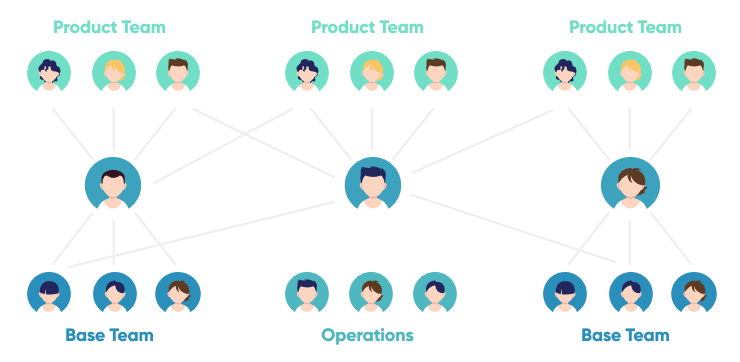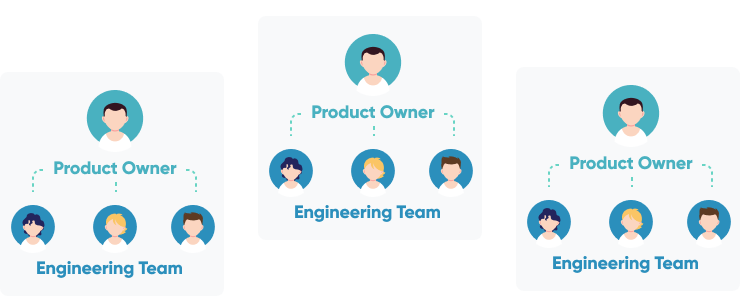For every organization, there’s a need for solid structures to be put in place to aid the smooth operation and interaction between the various levels and departments. Software engineering organizations are no less different. For smooth operations and proper handling of projects, there is a need for an organizational structure.
Organization structures differ between organizations. We will examine the different teams like the functional teams, the matrix teams, and the product teams. We will consider the benefits and challenges of each of these teams, and we will look at how you can implement the software engineering organizational structures.
Software engineering organizational structure

Functional team

In this organizational structure, employees who perform the same or similar functions are put under a department. The functional teams’ system is the most widely used of the three organizational structures. It involves dividing the organization structure along functional departments like the sales department, finance department, research department, production department, etc.
Each of the departments has a head that manages every member of the team and reports to a higher authority on the organization’s leadership hierarchy. This form of organization is perfect for large firms and corporations. If your firm has a small size, it is advised to go for structures that allow for more flexibility in functions.
Benefits of functional teams
Operational Clarity: One of the significant benefits of the functional team’s organizational structure is that it allows specialists in particular fields to concentrate their effort on their areas of strength. It effectively specifies each person and department’s duties giving room for operational clarity
Ease of staffing: Because this structure specifies the responsibilities of teams and departments, adding new hires into the firm becomes easier. New hires are easily onboarded into the operations of their specific departments.
Efficient handling of problems with human resources turnover: In an organizational structure with defined departments, issues arising from the turnover of personnel and staff are easily tackled and efficiently solved.
High-quality documentation practices: Due to the proper identification of teams and departments, the documentation process in firms with the functional organizational structure is always practical and top-notch.
Challenges of functional teams
Teams become siloed: Due to the separation of concerns according to departments, coworkers in this organizational structure tend to be isolated, thereby reducing the opportunities for them to meet and share perspectives.
Reduced flexibility to allocate resources where they are needed: Due to the levels of management within each department’s sub-units and the organization at large, it becomes a little more rigid to allocate resources as needed.
Matrix team

The matrix form of organizational structure combines the two other forms of corporate systems to manage projects. Despite being divided according to departments, matrix teams are constantly in cross-departmental cooperation. That makes it easy for them to achieve the company’s goal.
If your software engineering organization is launching a new product or starting a new marketing strategy/goal, the matrix team is always an excellent choice.
Benefits of matrix teams
Clearly Defined Objective: Matrix teams from inception always have a defined objective. The objective can range from the introduction of new lines of products to the creation of new strategies. Whatever the aim might be, it is always clearly defined from the beginning.
Fosters communication and cooperation among staff: If you run a matrix organizational structure for your firm, it allows your staff members to come together and jointly work to achieve a common goal.
Challenges of matrix teams
The complexity of operation and authority: The primary disadvantage or challenge you might face when running a matrix team is the complexity of process and administration. Due to the multiple administration structure, matrix teams might meet conflicting directives leading to complexity in operation.
Requires a higher level of managerial talent: As a result of the considerable authority and complex structure of matrix teams, the managers must possess a high level of skill to deliver their job efficiently.
Product teams

Product teams are also referred to as division teams. The organizational structure for software engineering firms requires you to divide your team along product lines, geographical lines, or service lines, among others.
Each of the divisions will then have their departmental segmentation as with functional team structure. For example, you can have your firm split according to products like Mobile Application, Partner Portal, etc. etc.
Benefits of product teams
Ensures accountability: Since each of the divisions that make up a product team structure has its leadership, they operate separately from the other divisions. That makes it possible for each division to be managed effectively, making it easy for you to assess performance across divisions.
Fosters adaptability to market conditions: Since each division operates independently, managers can quickly adapt their division’s strategies to meet current market conditions instead of waiting for approval from higher authorities.
Challenges of product teams
Cost of operation: Before adopting a product or division-based organizational structure, you must consider the cost. To setup and operate a product team’s organizational structure requires a lot of capital.
Possibilities of Inter-divisional rivalry: If the interactions between divisions are not fostered and adequately managed, it might lead to a situation where the divisions will develop unhealthy rivalry while trying to prove their superiority to other divisions within the organization.
Implementing engineering organizational structures
Before you make changes to your firm’s organizational structure, you must understand that it is not enough to make the decision. There are things that you must consider and put in place before going on with the iteration.
You can not simply admire another firm’s organizational structure and adopt it. Doing so may badly hurt the operation of your organization or lead to even more grave consequences. For this reason, we have answered your question on how to implement an engineering organizational structure adequately.
The primary goal of adopting or iterating your software engineering company’s structure is to make the best use of your available human and capital resources to generate results. Therefore, below are things to consider before making a decision.
Understand the problem
The first step to solving all and any problem is to understand that problem. That also applies when you’re trying to adopt a new organizational structure. You must first look through your company and decide precisely where you are having issues. Doing that is paramount to making the right decision and can therefore not be excused.
Decide who decides
It sounds like a cheesy play on words, but this is an essential point to note. While you might consider a flat structure of organization a nice one and feel equality is excellent for your company, having recognized decision-maker(or makers) is always better. When you decide who makes decisions in your company, organizational operations become much more manageable and smooth.
Create room for experimentation
The more open to experiments your team is, the better your organization becomes. Therefore, you must encourage experimentations within the organizations. Doing that will allow you to make discoveries that will help you make informed and better organizational structure decisions.
Over communicate
This is yet another bold but essential point. You must understand that while making adjustments or iterations in your software engineering organization’s structure, there will be consequences that might ricochet across the organization. It is, therefore, crucial that you ensure that you communicate well about the situation to your team members. That will help them understand the changes and also help them manage the situation better. Keep in mind that no amount of communication is too much; therefore, over-communicate if need be.
Conclusion
Software engineering organizational structure significantly impacts its ability to execute projects effectively and adapt to market changes. Functional, matrix, and product team structures each offer unique benefits and come with distinct challenges, such as operational clarity or complexity, staffing efficiency, or inter-divisional rivalry.
When implementing or iterating an organizational structure, it's crucial to understand the specific needs and problems of the organization, identify clear decision-making processes, foster a culture of experimentation, and maintain robust communication channels.







